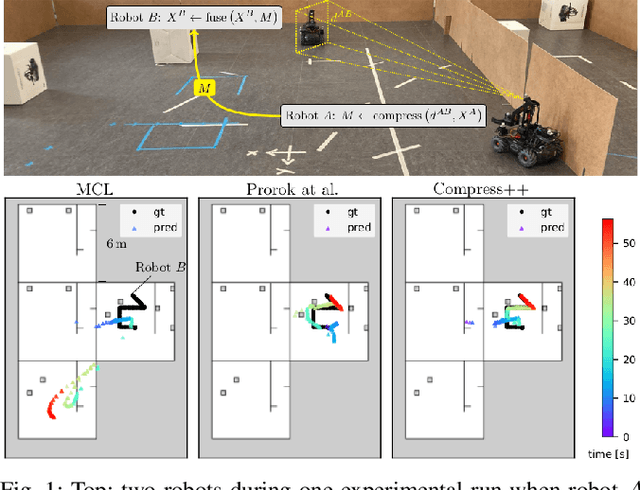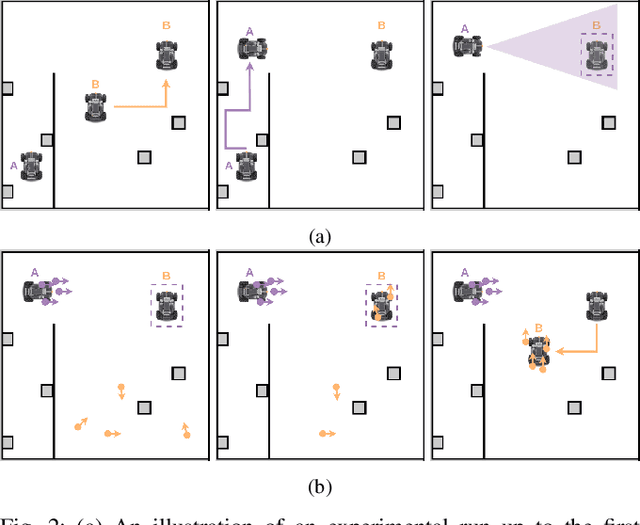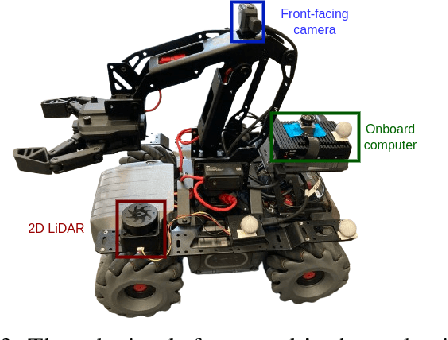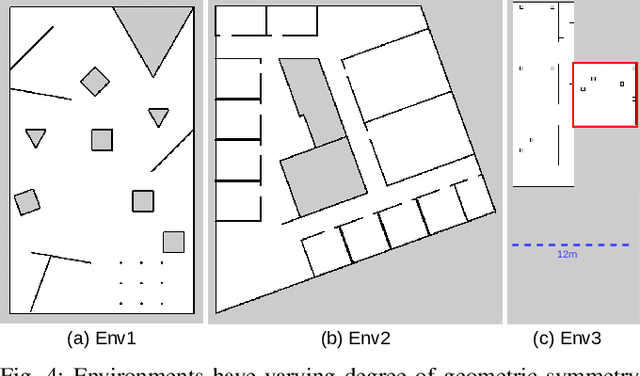Alessandro Giusti
Dalle Molle Institute for Artificial Intelligence
Sixth-Sense: Self-Supervised Learning of Spatial Awareness of Humans from a Planar Lidar
Feb 28, 2025Abstract:Localizing humans is a key prerequisite for any service robot operating in proximity to people. In these scenarios, robots rely on a multitude of state-of-the-art detectors usually designed to operate with RGB-D cameras or expensive 3D LiDARs. However, most commercially available service robots are equipped with cameras with a narrow field of view, making them blind when a user is approaching from other directions, or inexpensive 1D LiDARs whose readings are difficult to interpret. To address these limitations, we propose a self-supervised approach to detect humans and estimate their 2D pose from 1D LiDAR data, using detections from an RGB-D camera as a supervision source. Our approach aims to provide service robots with spatial awareness of nearby humans. After training on 70 minutes of data autonomously collected in two environments, our model is capable of detecting humans omnidirectionally from 1D LiDAR data in a novel environment, with 71% precision and 80% recall, while retaining an average absolute error of 13 cm in distance and 44{\deg} in orientation.
An Efficient Ground-aerial Transportation System for Pest Control Enabled by AI-based Autonomous Nano-UAVs
Feb 20, 2025Abstract:Efficient crop production requires early detection of pest outbreaks and timely treatments; we consider a solution based on a fleet of multiple autonomous miniaturized unmanned aerial vehicles (nano-UAVs) to visually detect pests and a single slower heavy vehicle that visits the detected outbreaks to deliver treatments. To cope with the extreme limitations aboard nano-UAVs, e.g., low-resolution sensors and sub-100 mW computational power budget, we design, fine-tune, and optimize a tiny image-based convolutional neural network (CNN) for pest detection. Despite the small size of our CNN (i.e., 0.58 GOps/inference), on our dataset, it scores a mean average precision (mAP) of 0.79 in detecting harmful bugs, i.e., 14% lower mAP but 32x fewer operations than the best-performing CNN in the literature. Our CNN runs in real-time at 6.8 frame/s, requiring 33 mW on a GWT GAP9 System-on-Chip aboard a Crazyflie nano-UAV. Then, to cope with in-field unexpected obstacles, we leverage a global+local path planner based on the A* algorithm. The global path planner determines the best route for the nano-UAV to sweep the entire area, while the local one runs up to 50 Hz aboard our nano-UAV and prevents collision by adjusting the short-distance path. Finally, we demonstrate with in-simulator experiments that once a 25 nano-UAVs fleet has combed a 200x200 m vineyard, collected information can be used to plan the best path for the tractor, visiting all and only required hotspots. In this scenario, our efficient transportation system, compared to a traditional single-ground vehicle performing both inspection and treatment, can save up to 20 h working time.
Learning Hand State Estimation for a Light Exoskeleton
Nov 14, 2024



Abstract:We propose a machine learning-based estimator of the hand state for rehabilitation purposes, using light exoskeletons. These devices are easy to use and useful for delivering domestic and frequent therapies. We build a supervised approach using information from the muscular activity of the forearm and the motion of the exoskeleton to reconstruct the hand's opening degree and compliance level. Such information can be used to evaluate the therapy progress and develop adaptive control behaviors. Our approach is validated with a real light exoskeleton. The experiments demonstrate good predictive performance of our approach when trained on data coming from a single user and tested on the same user, even across different sessions. This generalization capability makes our system promising for practical use in real rehabilitation.
Hearing the Robot's Mind: Sonification for Explicit Feedback in Human-Robot Interaction
Nov 14, 2024Abstract:Social robots are required not only to understand human intentions but also to effectively communicate their intentions or own internal states to users. This study explores the use of sonification to provide explicit auditory feedback, enhancing mutual understanding in HRI. We introduce a novel sonification approach that conveys the robot's internal state, linked to its perception of nearby individuals and their interaction intentions. The approach is evaluated through a two-fold user study: an online video-based survey with $26$ participants and live experiments with $10$ participants. Results indicate that while sonification improves the robot's expressivity and communication effectiveness, the design of the auditory feedback needs refinement to enhance user experience. Participants found the auditory cues useful but described the sounds as uninteresting and unpleasant. These findings underscore the importance of carefully designed auditory feedback in developing more effective and engaging HRI systems.
Multi-LED Classification as Pretext For Robot Heading Estimation
Oct 06, 2024Abstract:We propose a self-supervised approach for visual robot detection and heading estimation by learning to estimate the states (OFF or ON) of four independent robot-mounted LEDs. Experimental results show a median image-space position error of 14 px and relative heading MAE of 17 degrees, versus a supervised upperbound scoring 10 px and 8 degrees, respectively.
A Service Robot in the Wild: Analysis of Users Intentions, Robot Behaviors, and Their Impact on the Interaction
Oct 04, 2024



Abstract:We consider a service robot that offers chocolate treats to people passing in its proximity: it has the capability of predicting in advance a person's intention to interact, and to actuate an "offering" gesture, subtly extending the tray of chocolates towards a given target. We run the system for more than 5 hours across 3 days and two different crowded public locations; the system implements three possible behaviors that are randomly toggled every few minutes: passive (e.g. never performing the offering gesture); or active, triggered by either a naive distance-based rule, or a smart approach that relies on various behavioral cues of the user. We collect a real-world dataset that includes information on 1777 users with several spontaneous human-robot interactions and study the influence of robot actions on people's behavior. Our comprehensive analysis suggests that users are more prone to engage with the robot when it proactively starts the interaction. We release the dataset and provide insights to make our work reproducible for the community. Also, we report qualitative observations collected during the acquisition campaign and identify future challenges and research directions in the domain of social human-robot interaction.
Systematic analysis of requirements for socially acceptable service robots
Sep 13, 2024Abstract:In modern society, service robots are increasingly recognized for their wide range of practical applications. In large and crowded social spaces, such as museums and hospitals, these robots are required to safely move in the environment while exhibiting user-friendly behavior. Ensuring the safe and socially acceptable operation of robots in such settings presents several challenges. To enhance the social acceptance in the design process of service robots, we present a systematic analysis of requirements, categorized into functional and non-functional. These requirements are further classified into different categories, with a single requirement potentially belonging to multiple categories. Finally, considering the specific case of a receptionist robotic agent, we discuss the requirements it should possess to ensure social acceptance.
Training on the Fly: On-device Self-supervised Learning aboard Nano-drones within 20 mW
Aug 06, 2024



Abstract:Miniaturized cyber-physical systems (CPSes) powered by tiny machine learning (TinyML), such as nano-drones, are becoming an increasingly attractive technology. Their small form factor (i.e., ~10cm diameter) ensures vast applicability, ranging from the exploration of narrow disaster scenarios to safe human-robot interaction. Simple electronics make these CPSes inexpensive, but strongly limit the computational, memory, and sensing resources available on board. In real-world applications, these limitations are further exacerbated by domain shift. This fundamental machine learning problem implies that model perception performance drops when moving from the training domain to a different deployment one. To cope with and mitigate this general problem, we present a novel on-device fine-tuning approach that relies only on the limited ultra-low power resources available aboard nano-drones. Then, to overcome the lack of ground-truth training labels aboard our CPS, we also employ a self-supervised method based on ego-motion consistency. Albeit our work builds on top of a specific real-world vision-based human pose estimation task, it is widely applicable for many embedded TinyML use cases. Our 512-image on-device training procedure is fully deployed aboard an ultra-low power GWT GAP9 System-on-Chip and requires only 1MB of memory while consuming as low as 19mW or running in just 510ms (at 38mW). Finally, we demonstrate the benefits of our on-device learning approach by field-testing our closed-loop CPS, showing a reduction in horizontal position error of up to 26% vs. a non-fine-tuned state-of-the-art baseline. In the most challenging never-seen-before environment, our on-device learning procedure makes the difference between succeeding or failing the mission.
Learning to Estimate the Pose of a Peer Robot in a Camera Image by Predicting the States of its LEDs
Jul 15, 2024



Abstract:We consider the problem of training a fully convolutional network to estimate the relative 6D pose of a robot given a camera image, when the robot is equipped with independent controllable LEDs placed in different parts of its body. The training data is composed by few (or zero) images labeled with a ground truth relative pose and many images labeled only with the true state (\textsc{on} or \textsc{off}) of each of the peer LEDs. The former data is expensive to acquire, requiring external infrastructure for tracking the two robots; the latter is cheap as it can be acquired by two unsupervised robots moving randomly and toggling their LEDs while sharing the true LED states via radio. Training with the latter dataset on estimating the LEDs' state of the peer robot (\emph{pretext task}) promotes learning the relative localization task (\emph{end task}). Experiments on real-world data acquired by two autonomous wheeled robots show that a model trained only on the pretext task successfully learns to localize a peer robot on the image plane; fine-tuning such model on the end task with few labeled images yields statistically significant improvements in 6D relative pose estimation with respect to baselines that do not use pretext-task pre-training, and alternative approaches. Estimating the state of multiple independent LEDs promotes learning to estimate relative heading. The approach works even when a large fraction of training images do not include the peer robot and generalizes well to unseen environments.
Resource-Aware Collaborative Monte Carlo Localization with Distribution Compression
Apr 02, 2024



Abstract:Global localization is essential in enabling robot autonomy, and collaborative localization is key for multi-robot systems. In this paper, we address the task of collaborative global localization under computational and communication constraints. We propose a method which reduces the amount of information exchanged and the computational cost. We also analyze, implement and open-source seminal approaches, which we believe to be a valuable contribution to the community. We exploit techniques for distribution compression in near-linear time, with error guarantees. We evaluate our approach and the implemented baselines on multiple challenging scenarios, simulated and real-world. Our approach can run online on an onboard computer. We release an open-source C++/ROS2 implementation of our approach, as well as the baselines
 Add to Chrome
Add to Chrome Add to Firefox
Add to Firefox Add to Edge
Add to Edge